match the name of the animal (colume I ) with one charcteristics (column II ) , and the phylun / class (column III ) to which it belongs
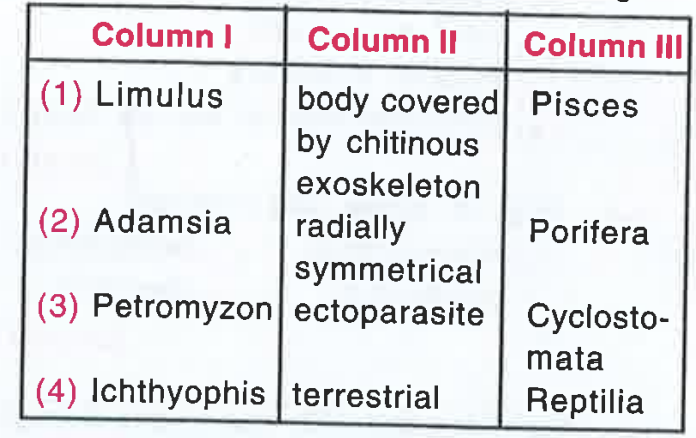
The correct Answer is:B
Step by step video, text & image solution for match the name of the animal (colume I ) with one charcteristics (column II ) , and the phylun / class (column III ) to which it belongs by Biology experts to help you in doubts & scoring excellent marks in Class 12 exams.
Topper's Solved these Questions
- BOOK - PHYSICS WALLAHCHAPTER - ANIMAL KINGDOMEXERCISE - LEVEL-230videos
ANIMAL KINGDOM
- BOOK - PHYSICS WALLAHCHAPTER - ANATOMY OF FLOWERING PLANTSEXERCISE - NEET PAST 10 YEARS QUESTIONS36videos
ANATOMY OF FLOWERING PLANTS
- BOOK - PHYSICS WALLAHCHAPTER - BIODIVERSITY AND CONSERVATIONEXERCISE - NEET Past 10 Years Questions31videos
BIODIVERSITY AND CONSERVATION
Similar Questions
Knowledge Check
- Question 1 - Select One
Match the name of the animal (Column I) with characteristics (Column II) and the phylum/class (column III) to which it belongs:
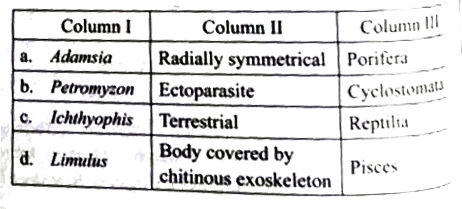 AOption (1)BOption (2)COption (3)DOption (4)
AOption (1)BOption (2)COption (3)DOption (4) - Question 2 - Select One
Match the name of the animal (Column I), with one characteristics (column II) and the phylum/class (column III )to which it belongs
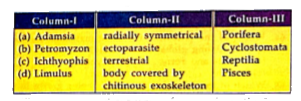 AColumn IColumn IIColumn IIILimulus Body covered by chitinous exoskeletonPiscesBColumn IColumn IIColumn IIIAdamsiaRadially symmetricalProiferaCColumn IColumn IIColumn IIIPetromyzonEctoparasiteCyclostomataDColumn IColumn IIColumn IIIIchthyphisTerrstriaReptilia
AColumn IColumn IIColumn IIILimulus Body covered by chitinous exoskeletonPiscesBColumn IColumn IIColumn IIIAdamsiaRadially symmetricalProiferaCColumn IColumn IIColumn IIIPetromyzonEctoparasiteCyclostomataDColumn IColumn IIColumn IIIIchthyphisTerrstriaReptilia - Question 3 - Select One
Match the name reaction ( column I) with the reagent ( column II) used .
 A(i) -C ,(ii)-AB(i) -B ,(ii )-CC(i) -B, (ii ) -AD( i) -A,(ii )-C
A(i) -C ,(ii)-AB(i) -B ,(ii )-CC(i) -B, (ii ) -AD( i) -A,(ii )-C

Match the name of animal (Column I), with one characteristic (Column II) and phylum/Class (Column III) to which is belongsView SolutionMatch the name reaction ( column I) with the reagent ( column II) used .
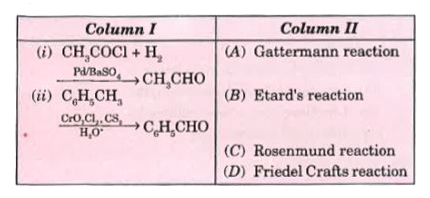 View Solution
View SolutionMatch the name reaction ( column I) with the reagent ( column II) used .
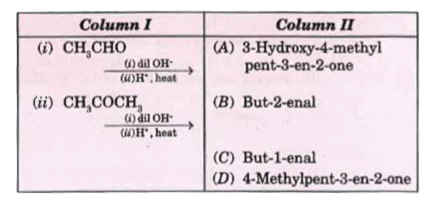 View Solution
View SolutionMatch the name reaction ( column I) with the reagent ( column II) used .
 View Solution
View SolutionMatch the name reaction ( column I) with the reagent ( column II) used .
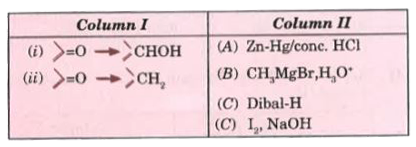 View Solution
View Solution

